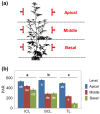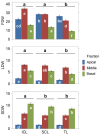Subcanopy and Inter-Canopy Supplemental Light Enhances and Standardizes Yields in Medicinal Cannabis (Cannabis sativa L.)
- PMID: 40431037
- PMCID: PMC12115249
- DOI: 10.3390/plants14101469
Subcanopy and Inter-Canopy Supplemental Light Enhances and Standardizes Yields in Medicinal Cannabis (Cannabis sativa L.)
Abstract
Light supplementation within the canopy is an effective method to improve light distribution throughout the whole plant, ensuring the inner canopies receive adequate light exposure to maximize overall growth. This approach is gaining interest among cannabis growers looking for more efficient lighting strategies to enhance their valuable production for medicinal purposes. We compared the traditional top lighting (TL) approach with two light supplementation methods: subcanopy lighting (SCL), which adds extra light to the inner canopies from below, and inter-canopy lighting (ICL), providing dedicated light at the basal and middle levels. Both SCL and ICL resulted in a more uniform light distribution throughout the plants and increased the yields of inflorescences, cannabinoids, and terpenes. The ICL treatment achieved the highest yield increases, showing a 29.95% increase in dry inflorescence yield, a 24.4% higher accumulation of THC, and a 12.5% increase in total terpene concentration. Notably, both SCL and ICL reduced the coefficients of variation, yielding more standardized products by decreasing the variability of the dry inflorescences yield, which also had more consistent chemical profiles, with reductions in variability for both THC and total terpene yields of over 50%. Although using more energy for lighting, SCL was more power-efficient for inflorescence and cannabinoid yields, while ICL was more efficient in achieving yield enhancements. In conclusion, adding supplemental light to the inner canopies enhances the profitability of medical cannabis cultivation, resulting in higher yields, improved energy efficiency, and more standardized products for research and medical purposes.
Keywords: LEDs; THC; inter-canopy; medicinal cannabis; standardization; subcanopy; terpenes.
Conflict of interest statement
The authors declare no conflicts of interest.
Figures





Similar articles
-
Too Dense or Not Too Dense: Higher Planting Density Reduces Cannabinoid Uniformity but Increases Yield/Area in Drug-Type Medical Cannabis.Front Plant Sci. 2022 Sep 29;13:713481. doi: 10.3389/fpls.2022.713481. eCollection 2022. Front Plant Sci. 2022. PMID: 36247643 Free PMC article.
-
Cannabis Inflorescence Yield and Cannabinoid Concentration Are Not Increased With Exposure to Short-Wavelength Ultraviolet-B Radiation.Front Plant Sci. 2021 Nov 2;12:725078. doi: 10.3389/fpls.2021.725078. eCollection 2021. Front Plant Sci. 2021. PMID: 34795683 Free PMC article.
-
The effects of plant density and duration of vegetative growth phase on agronomic traits of medicinal cannabis (Cannabis sativa L.): A regression analysis.PLoS One. 2024 Dec 30;19(12):e0315951. doi: 10.1371/journal.pone.0315951. eCollection 2024. PLoS One. 2024. PMID: 39774473 Free PMC article.
-
Cannabinoids and Terpenes: How Production of Photo-Protectants Can Be Manipulated to Enhance Cannabis sativa L. Phytochemistry.Front Plant Sci. 2021 May 31;12:620021. doi: 10.3389/fpls.2021.620021. eCollection 2021. Front Plant Sci. 2021. PMID: 34135916 Free PMC article. Review.
-
Illuminating Cannabis sativa L.: The Power of Light in Enhancing C. sativa Growth and Secondary Metabolite Production.Plants (Basel). 2024 Oct 3;13(19):2774. doi: 10.3390/plants13192774. Plants (Basel). 2024. PMID: 39409645 Free PMC article. Review.
References
-
- Small E. Evolution and Classification of Cannabis sativa (Marijuana, Hemp) in Relation to Human Utilization. Bot. Rev. 2015;81:189–294. doi: 10.1007/s12229-015-9157-3. - DOI
Grants and funding
LinkOut - more resources
Full Text Sources
Research Materials
Miscellaneous

